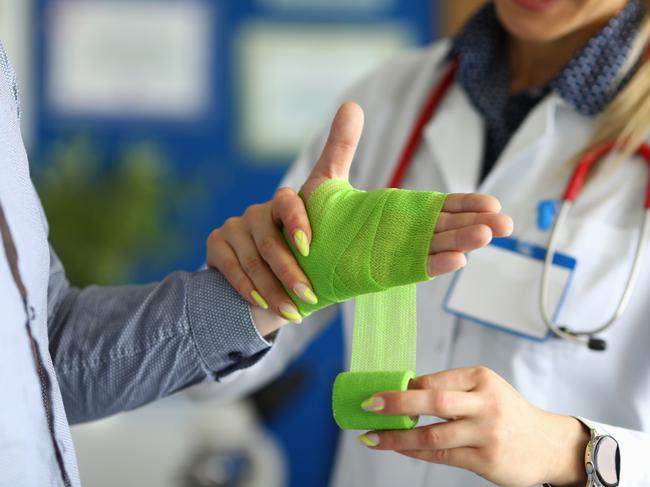Wound care crisis a ‘hidden epidemic’ that needs urgent government attention
Living with chronic wounds is devastating enough without the crippling costs that come with them, says GP and AMA vice-president Dr Danielle McMullen.
National
Don't miss out on the headlines from National. Followed categories will be added to My News.
Wound Awareness Week comes once a year, but as a GP I see the impact wounds have every day of the year on affected patients — the impact on their health and quality of life: constant pain, social isolation, sleep and mobility problems, and mental health issues.
If not treated properly, wounds can be life threatening, requiring treatment for severe infections and in some cases, amputation.
Chronic wounds affect around half a million Australians at any given time and cost the health system an estimated $3 billion each year.
This represents about two per cent of our national healthcare expenditure and is likely to be an underestimate due to the lack of reliable data in Australia.
This is significant, and the burden will only get worse as Australia’s population continues to grow, age, and develop more complex and chronic conditions. Yet, chronic wounds continue to be an unrecognised and underfunded public health issue.
Most of these wounds are managed in the community, with general practices playing a key role.
Those of us who treat these wounds know that best-practice care with best-practice wound dressings and products is essential to reducing this significant burden.
But this care is expensive and time consuming, and many of the patients we treat with chronic wounds are often older Australians, Aboriginal and Torres Strait Islander people, or patients with other chronic conditions.

These are vulnerable patients who are often on limited incomes due to their stage of life or reduced capacity to work.
Where possible, we minimise the out-of-pocket costs for these patients but under current Medicare rules, GPs are unable to bulk-bill a patient for the consultation and charge just the cost of the dressing.
So we must decide whether to bulk-bill the patient and absorb the cost of the dressing — with the entire service often performed at a financial loss — or charge the patient for both the consultation and the dressing.
We shouldn’t have to make this choice, but after years of frozen and inadequate Medicare rebates, GPs are just not in a position to subsidise these costs. Patient care suffers as a result.
In many cases, patients buy their dressings and other consumables at market rates from a pharmacy, just so the GP treating the wound can bulk-bill them for the consultation.
Patients can live with these wounds for months or even years, so the costs add up. Patients could be paying up to $340 a month, or nearly $4000 a year, in out-of-pocket costs.
A redback spider bite that won’t heal is costing an Aussie mum $1300 a week
When a patient cannot afford these high costs, they often skip dressing changes or choose cheaper suboptimal dressings, and their wound takes even longer to heal — it becomes a self-perpetuating cycle. But it doesn’t have to be this way.
The AMA’s new report Solutions to the chronic wound problem in Australia offers answers, proposing a five-point plan to improve patient access to best-practice wound care through their general practitioner, and to give patients’ wounds the best chance to heal. If implemented, the plan would provide patients with diabetic foot ulcers, arterial leg ulcers, and venous leg ulcers access to subsidised wound dressings through their general practice, and a more co-ordinated approach to evidence-based care led by the GP through the introduction of new MBS items — an estimated government investment of $23.4 million over the next four years.
The AMA is not alone in its call for better wound care for Australians with chronic wounds. Many other health organisations are also calling for action on this hidden epidemic.

The solutions proposed by the AMA build on the recommendations outlined by the MBS Review Taskforce Wound Management Working Group, many of which have still not been implemented by government.
We anticipate the AMA’s solutions will free up GP time and reduce the strain on other healthcare settings including hospitals and outpatient clinics.
With Australia now facing a serious GP workforce shortage and a hospital crisis, these solutions can support general practices to deliver more care to their communities and reduce the strain on other parts of our health system which are struggling.
As the AMA’s analysis indicates, receiving care through general practice is (overall) cheaper than receiving care through an outpatient hospital clinic or other community healthcare setting. The proposed solutions will save the government money — an estimated $203.4 million over the next four years. This is huge return on investment — $8.68 for every $1 invested, and the return will only increase as more patients receive care through their general practice.
The previous government acknowledged that general practices should not have to wear the cost of consumables and there should be “alternative sources of government support”, however a funded wound consumables scheme is yet to be implemented.
The new government now has an opportunity to act on this and increase access to affordable wound care and improve the lives of those living with chronic wounds.
The solution we have proposed will not only improve patient outcomes but will also save money in the long run. The government should choose to heal the wounds caused by this hidden epidemic.
Dr Danielle McMullen is a GP, vice-president of the Australian Medical Association and the former NSW president of the Australian Medical Association.




